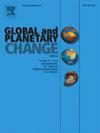中白垩纪海洋缺氧事件中海洋氧化还原条件的瞬态模拟2
IF 4
1区 地球科学
Q1 GEOGRAPHY, PHYSICAL
引用次数: 0
摘要
对中白垩世海洋缺氧事件2 (OAE2)的重建表明,海洋氧化还原状态在时间和空间上是不均匀的。其演变被认为是由大火成岩省(LIPs)活动引起的大气二氧化碳浓度(pCO2)的变化以及与之相关的全球经向翻转环流、养分输入和磷循环的变化引起的。然而,它们各自在OAE2上的角色仍在争论中。在这里,我们使用一个中等复杂的地球系统模型进行瞬态数值模拟,并重建了pCO2值。在我们的模拟中,在OAE2之前,海底缺氧发生在赤道大西洋和特提斯边缘。这只随着二氧化碳分压的变化而略有变化。相比之下,由于大陆风化作用的增加,营养物质浓度的增加会导致缺氧区域的显著增加,而低氧海洋区域磷循环的增强则进一步扩大了缺氧区域。北大西洋、低纬度南大西洋、东南太平洋和西特提斯海最容易发生底水缺氧。在不同的风化强度下,模拟的缺氧区在OAE2期间表现出明显不同的时空格局。模拟结果与新收集的地质记录对比表明,缺氧底水仅占全球底面积的~ 20-40 %,大陆磷风化强度比oae2前增加了~ 40-60 %。本文章由计算机程序翻译,如有差异,请以英文原文为准。
Transient modeling for ocean redox conditions during the mid-cretaceous Oceanic Anoxic Event 2
Reconstructions of the mid-Cretaceous Oceanic Anoxic Event 2 (OAE2) indicate that the ocean redox state was temporally and spatially heterogeneous. Its evolution is considered to be induced by the variation of atmospheric carbon dioxide concentrations (pCO2) due to the activities of large igneous provinces (LIPs) and associated changes in global meridional overturning circulation, nutrient input, and phosphorus recycling. However, their respective roles on the OAE2 are still under debate. Here, we conduct transient numerical simulations using an intermediate-complexity Earth system model with reconstructed pCO2 values. In our simulations, bottom anoxia occurred in the equatorial Atlantic Ocean and the Tethyan rim before OAE2. This changed only slightly with varying pCO2. In contrast, increasing nutrient concentrations due to increased continental weathering can lead to a marked increase in anoxic areas, which is further expanded by enhanced phosphorus recycling in the low-oxygen marine area. The North Atlantic, low-latitude South Atlantic, Southeast Pacific, and Western Tethys oceans are most prone to developing bottom water anoxia. The modeled anoxic areas exhibit distinctly different spatio-temporal patterns during OAE2 with varying weathering intensities. Comparison of the simulation results with newly assembled geological records suggests that anoxic bottom water only accounted for ∼20–40% of the global bottom area and that the continental phosphorus weathering intensity was increased by ∼40–60% compared to the pre-OAE2 level.
求助全文
通过发布文献求助,成功后即可免费获取论文全文。
去求助
来源期刊

Global and Planetary Change
地学天文-地球科学综合
CiteScore
7.40
自引率
10.30%
发文量
226
审稿时长
63 days
期刊介绍:
The objective of the journal Global and Planetary Change is to provide a multi-disciplinary overview of the processes taking place in the Earth System and involved in planetary change over time. The journal focuses on records of the past and current state of the earth system, and future scenarios , and their link to global environmental change. Regional or process-oriented studies are welcome if they discuss global implications. Topics include, but are not limited to, changes in the dynamics and composition of the atmosphere, oceans and cryosphere, as well as climate change, sea level variation, observations/modelling of Earth processes from deep to (near-)surface and their coupling, global ecology, biogeography and the resilience/thresholds in ecosystems.
Key criteria for the consideration of manuscripts are (a) the relevance for the global scientific community and/or (b) the wider implications for global scale problems, preferably combined with (c) having a significance beyond a single discipline. A clear focus on key processes associated with planetary scale change is strongly encouraged.
Manuscripts can be submitted as either research contributions or as a review article. Every effort should be made towards the presentation of research outcomes in an understandable way for a broad readership.
 求助内容:
求助内容: 应助结果提醒方式:
应助结果提醒方式:


